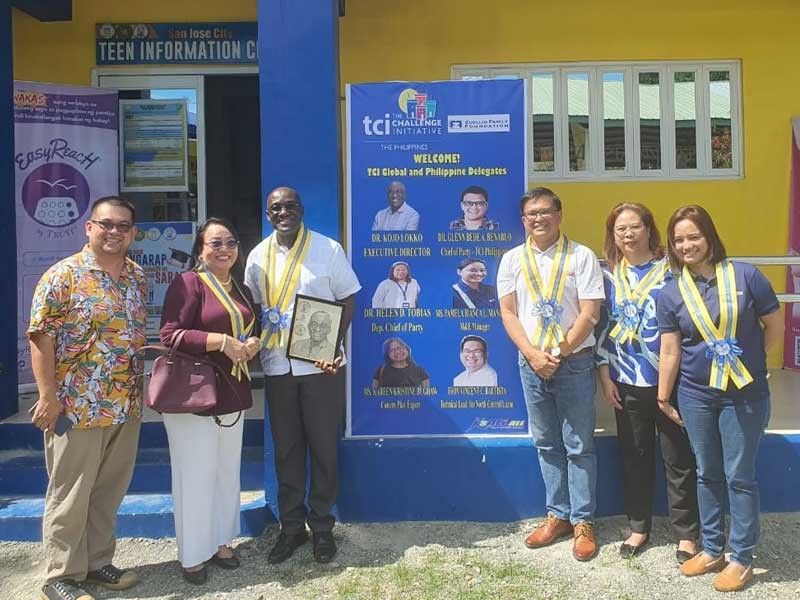Curbing adolescent pregnancies takes focus in TCI partnership with LGUs
Curbing adolescent pregnancies takes focus in TCI partnership with LGUs Philstar.com


It Takes a Village: The Challenge Initiative (TCI) Philippines

Introduction
November 22, 2023 | 12:00am
The Challenge Initiative (TCI) Philippines, following its “Business Unusual” approach, aims to assist cities in effectively planning for the well-being of their children and adolescents. By providing a safe and healthy environment, these young individuals can develop and thrive as active members of their communities.
Implementation of High-Impact Practices
Currently, 24 cities in the Philippines are implementing high-impact practices in Family Planning (FP) and Adolescent Sexual and Reproductive Health (ASRH). Dr. Kojo Lokko, the executive director of TCI, recently visited the country from November 6-9 to gain insights from the hub team and assess the program’s impact at the city level.
City Visits and Workshops
During his visit, Lokko had the opportunity to visit San Jose in Nueva Ecija and Naga in Camarines Sur. He also attended a workshop organized by the Manila Health Department and engaged with members of the Pasig City Leadership Team.
Impressions and Achievements
Lokko expressed his appreciation for the program’s achievements, particularly in San Jose City, which is co-managed by the Zuellig Family Foundation (ZFF). San Jose City has successfully maintained a controlled adolescent birth rate of 33 per 1,000 girls and a modern contraceptive prevalence rate of 33%, surpassing national benchmarks set by the Department of Health (DOH). The city’s investment in adolescent-friendly health facilities has significantly contributed to these accomplishments.
Positive Health-Seeking Behavior
During Lokko’s visit to San Jose City, its health officials showcased the readiness of rural health units and public hospitals to provide FP and ASRH services 24/7. Their goal is to promote positive health-seeking behavior among the target groups.
Teen Hubs as Safe Spaces
In Naga City, Lokko witnessed the emergence of teen hubs as safe spaces within public schools. This was made possible through an ASRH ordinance passed earlier in the year. These hubs provide students with access to health advice, personal time, and peer educators who can listen to their struggles as young individuals.
Importance of Inclusion
Lokko emphasized the need for mechanisms to reach out to everyone, including boys, in order to address adolescent pregnancies effectively. He also highlighted the importance of prioritizing learning from mistakes rather than striving for perfection in program implementation.
Addressing Challenges in Pasig City
The TCI team and city health leaders in Pasig City discussed communication gaps and a lack of synergy among relevant agencies. These issues have affected the continuity of care, led to duplicated efforts, and hindered access to accurate data. Possible solutions, such as implementing electronic medical and health information systems and community-based teen centers, were suggested by TCI Philippine Hub Chief of Party Glenn Benablo.
Digitalization for Better Outcomes
Dr. Lokko commended Manila City for its digitalization efforts in addressing adolescent pregnancies and low uptake of FP services. He highlighted the importance of real-time data in facilitating high-impact interventions. The Manila Data Analytics and Technology Online Services (ManDATOS) Konsulta Performance Dashboard, showcased during a health information exchange event, received praise for its role in visualizing family planning data.
Shared Work and Future Plans
TCI and the Zuellig Family Foundation are entering their fourth year of collaboration on FP and ASRH in the Philippines in 2024. The program has seen significant successes in reducing teen pregnancies and increasing the use of modern contraceptives in cities like Cagayan de Oro and Dipolog. These cities are now preparing for graduation from the program.
SDGs, Targets, and Indicators in the Article
1. Which SDGs are addressed or connected to the issues highlighted in the article?
- SDG 3: Good Health and Well-being
- SDG 4: Quality Education
- SDG 5: Gender Equality
- SDG 10: Reduced Inequalities
- SDG 17: Partnerships for the Goals
The article discusses the efforts of The Challenge Initiative (TCI) Philippines in implementing high-impact practices in Family Planning (FP) and Adolescent Sexual and Reproductive Health (ASRH) in various cities. These efforts are directly related to SDG 3, which aims to ensure good health and well-being for all, including reproductive health. Additionally, the article mentions the establishment of safe spaces in public schools and the need for multi-sectoral collaboration, which align with SDG 4 (quality education) and SDG 5 (gender equality). The article also highlights the importance of partnerships and collaboration, connecting to SDG 17.
2. What specific targets under those SDGs can be identified based on the article’s content?
- Target 3.7: By 2030, ensure universal access to sexual and reproductive health-care services, including for family planning, information and education, and the integration of reproductive health into national strategies and programs.
- Target 4.7: By 2030, ensure that all learners acquire the knowledge and skills needed to promote sustainable development, including, among others, through education for sustainable development and sustainable lifestyles.
- Target 5.6: Ensure universal access to sexual and reproductive health and reproductive rights as agreed in accordance with the Program of Action of the International Conference on Population and Development and the Beijing Platform for Action and the outcome documents of their review conferences.
- Target 10.3: Ensure equal opportunity and reduce inequalities of outcome, including by eliminating discriminatory laws, policies, and practices and promoting appropriate legislation, policies, and action in this regard.
- Target 17.17: Encourage and promote effective public, public-private, and civil society partnerships, building on the experience and resourcing strategies of partnerships.
Based on the article’s content, the specific targets that can be identified are related to ensuring universal access to sexual and reproductive health services (Target 3.7), promoting education for sustainable development (Target 4.7), ensuring universal access to sexual and reproductive health and rights (Target 5.6), reducing inequalities (Target 10.3), and promoting effective partnerships (Target 17.17).
3. Are there any indicators mentioned or implied in the article that can be used to measure progress towards the identified targets?
- Indicator 3.7.1: Proportion of women of reproductive age (aged 15-49 years) who have their need for family planning satisfied with modern methods
- Indicator 4.7.1: Extent to which (i) global citizenship education and (ii) education for sustainable development are mainstreamed in (a) national education policies; (b) curricula; (c) teacher education; and (d) student assessment
- Indicator 5.6.1: Proportion of women aged 15-49 years who make their own informed decisions regarding sexual relations, contraceptive use, and reproductive health care
- Indicator 10.3.1: Proportion of population reporting having personally felt discriminated against or harassed in the previous 12 months on the basis of a ground of discrimination prohibited under international human rights law
- Indicator 17.17.1: Amount of United States dollars committed to (a) public-private partnerships and (b) civil society partnerships
The article mentions indicators that can be used to measure progress towards the identified targets. These include the proportion of women of reproductive age who have their need for family planning satisfied (Indicator 3.7.1), the extent to which education for sustainable development is mainstreamed in national education policies (Indicator 4.7.1), the proportion of women who make their own informed decisions regarding reproductive health care (Indicator 5.6.1), the proportion of population reporting discrimination (Indicator 10.3.1), and the amount of funding committed to partnerships (Indicator 17.17.1).
4. Table: SDGs, Targets, and Indicators
| SDGs | Targets | Indicators |
|---|---|---|
| SDG 3: Good Health and Well-being | Target 3.7: By 2030, ensure universal access to sexual and reproductive health-care services, including for family planning, information and education, and the integration of reproductive health into national strategies and programs. | Indicator 3.7.1: Proportion of women of reproductive age (aged 15-49 years) who have their need for family planning satisfied with modern methods |
| SDG 4: Quality Education | Target 4.7: By 2030, ensure that all learners acquire the knowledge and skills needed to promote sustainable development, including, among others, through education for sustainable development and sustainable lifestyles. | Indicator 4.7.1: Extent to which (i) global citizenship education and (ii) education for sustainable development are mainstreamed in (a) national education policies; (b) curricula; (c) teacher education; and (d) student assessment |
| SDG 5: Gender Equality | Target 5.6: Ensure universal access to sexual and reproductive health and reproductive rights as agreed in accordance with the Program of Action of the International Conference on Population and Development and the Beijing Platform for Action and the outcome documents of their review conferences. | Indicator 5.6.1: Proportion of women aged 15-49 years who make their own informed decisions regarding sexual relations, contraceptive use, and reproductive health care |
| SDG 10: Reduced Inequalities | Target 10.3: Ensure equal opportunity and reduce inequalities of outcome, including by eliminating discriminatory laws, policies, and practices and promoting appropriate legislation, policies, and action in this regard. | Indicator 10.3.1: Proportion of population reporting having personally felt discriminated against or harassed in the previous 12 months on the basis of a
Behold! This splendid article springs forth from the wellspring of knowledge, shaped by a wondrous proprietary AI technology that delved into a vast ocean of data, illuminating the path towards the Sustainable Development Goals. Remember that all rights are reserved by SDG Investors LLC, empowering us to champion progress together. Source: philstar.com
Join us, as fellow seekers of change, on a transformative journey at https://sdgtalks.ai/welcome, where you can become a member and actively contribute to shaping a brighter future.
|








